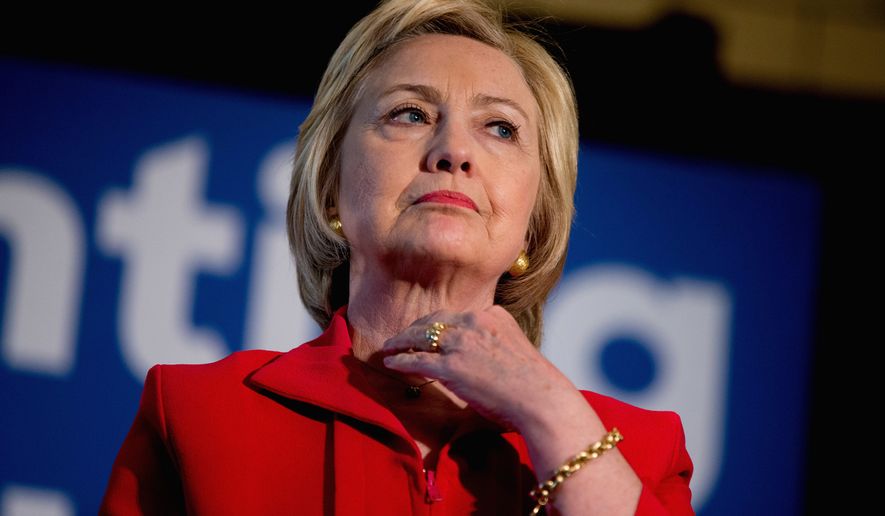Separated by at least 7 inches in height, presidential contenders Donald Trump and Hillary Clinton are set to test the adage that “size matters,” according to researchers, who have found that voters, whether they acknowledge it or not, are often influenced by a candidate’s physical stature and overall appearance.
Height is just one of the crazier — but often accurate — predictors of a presidential election outcome. Other striking harbingers of success are eye color and length of name. Blue eyes seem to win out, and candidates with more letters in their last names tend to emerge victorious.
But height is one of the most pervasive tests. The taller candidate has won the popular vote in more than two-thirds of the elections since 1950.
On that score, Mr. Trump is clearly ahead — though by how much is not clear.
The presumptive Republican nominee is 6 feet 2 inches tall, but Mrs. Clinton’s height has been a moving target. Some calculations put her at 5 feet 4 inches, but her 2008 campaign staff told The Washington Post that she was 5 feet 5 inches. Now, multiple press reports put her at 5 feet 7 inches.
The Democratic front-runner’s campaign isn’t rushing to correct the record and has ignored a request for comment from The Washington Times.
But analysts said the growth spurt, at an age where most people lose elevation, is likely not an accident but rather a reflection of the American voter.
“As difficult or as distasteful as it might be to believe, a substantial number of voters in the electorate might cast their vote for a presidential candidate influenced by, and maybe even determined by, personal traits of the candidates such as her or his looks,” said Gordon Patzer, a professor at Roosevelt University in Chicago who studies the “attractiveness phenomenon.”
“The relationship between height and success has to be more than coincidental given that throughout American history the taller of the two major presidential candidates has with very few exceptions been the candidate elected to be U.S. president.”
Height is just one of the yardsticks that have become a cottage market for election prognosticators, who turn to all sorts of offbeat ideas to predict winners.
A theory called the “Redskins Rule” posits that the outcome of the Washington Redskins football team’s last home game can help forecast the party that will win the general election. The hypothesis arguing that candidates with more letters in their last names have fared better than their rivals could be a good omen for Mrs. Clinton, who has a two-letter edge over Mr. Trump.
Other theories draw correlations between a candidate’s dominant hand, the better head of hair and eye color.
Both Mrs. Clinton and Mr. Trump have blue eyes, which, despite being relatively rare in society, happens to be the most common color for presidents. Both are right-handed, which puts them at odds with three of the past four presidents, and both have, to varying degrees, hair — a point that Mr. Trump had supporters prove at campaign stops this year by pulling on his thin crop.
But height may be the granddaddy test, with studies showing taller candidates tend to outperform more diminutive rivals.
Indeed, Mr. Trump topped a field of 16 other candidates, all but one of whom was shorter. Only former Florida Gov. Jeb Bush stood taller than the billionaire businessman on stage.
Gert Stulp, a researcher at the University of Groningen in the Netherlands who co-authored a report on the influence of height in U.S. elections, said in an email that “taller individuals are perceived to have a series of more favorable qualities, such as higher intelligence, better leadership skills, better communications skills, more dominant, higher attractiveness, that people may consider important in their leaders — at least currently.”
Mr. Trump has played into the perception, touting his strength and leadership abilities while resisting any insinuation to the contrary — even graphically arguing during the primary race about the size of his hands.
Mr. Stulp said presidents on average are increasingly taller than the general population, suggesting that height has risen in importance.
“Particularly after the invention of the television, voters have become much more aware of the physical appearance of the presidential candidates, which may have resulted in the increase in importance of physical appearance,” Mr. Stump said.
Mrs. Clinton, though, could blow a hole in the theory. She is poised to win the Democratic primary amid a field of taller candidates, including 6-foot Sen. Bernard Sanders of Vermont.
That has Mr. Stulp and other analysts wondering whether female candidates will play into the trend or rewrite the rules.
“Your guess is as good as mine,” he said, adding that it remains to be seen whether voters will grade on a curve and expect women to be shorter than men.
That could be why the Clinton campaign appears eager to allow her height to be reported at 5 feet 7 inches, about 3 inches taller than average for an American woman.
Mr. Patzer said the Clinton team is probably preparing for debate showdowns by ensuring she does not look small compared with Mr. Trump. He said strategists are probably talking about the handshakes on stage, where “a portion of the electorate may be influenced so much so by the person’s height that it might overshadow the neutrality or even the distaste they have toward a person.”
He doubted that voters would be forgiving about Mrs. Clinton’s gender.
“At that point it is going to be height versus height, and at that point it might amplify in a voter’s mind that this candidate, who happens to be a women, that maybe she does not have the same strength, power or influence of this taller man,” he said. “As sexist as it sounds to me to say that, objectively that could be the case.”
• Seth McLaughlin can be reached at smclaughlin@washingtontimes.com.




Please read our comment policy before commenting.